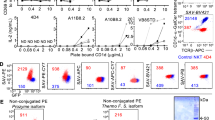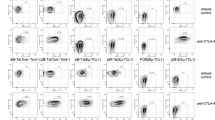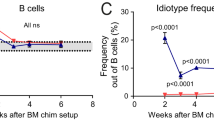Abstract
The first step in the induction of immune responses, whether humoral or cell mediated, requires the interaction between antigen-presenting cells and T lymphocytes restricted at the major histo-compatibility complex (MHC)1,2. These cells invariably express MHC class II molecules (HLA-D region in man and Ia in mouse) which are recognized by T cells of the helper/inducer subset in association with antigen fragments3,4. Interestingly, in certain pathological conditions5–8, for example in autoimmune diseases such as thyroiditis5 and diabetic insulitis6, class II molecules may be expressed on epithelial cells that normally do not express them. We speculated that these cells may be able to present their surface autoantigens to T cells, and that this process may be crucial to the induction and maintenance of autoimmunity9. A critical test of this hypothesis would be to determine whether epithelial cells bearing MHC class II molecules (class II+ cells) can present antigen to T cells. We report here that class II+thyroid follicular epithelial cells (thyrocytes) can indeed present viral peptide antigens to cloned human T cells.
This is a preview of subscription content, access via your institution
Access options
Subscribe to this journal
Receive 51 print issues and online access
$199.00 per year
only $3.90 per issue
Buy this article
- Purchase on SpringerLink
- Instant access to full article PDF
Prices may be subject to local taxes which are calculated during checkout
Similar content being viewed by others
References
Erb, P. & Feldmann, M. Nature 254, 352–354 (1975).
Wagner, H., Feldmann, M., Boyle, W. & Schrader, J. W. J. exp. Med. 136, 331–343 (1972).
Unanue, E. R., Beller, D. I., Lu, C. Y. & Allen, P. M. J. Immun. 132, 1–5 (1984).
Shimonkevitz, R., Kappler, J., Marrack, P. & Grey, H. M. J. exp. Med. 158, 303–316 (1983).
Hanafusa, T. et al. Lancet ii, 1111–1115 (1983).
Bottazzo, G. F. & Dean, B. M. Diabetologica 27, 259a (1984).
Ballardini, G. et al. Lancet 11, 1009–1013 (1984).
Mason, D. W., Dallman, M. & Barclay, A. N. Nature 239, 150–152 (1981).
Bottazzo, G. F., Pujol-Borrell, R., Hanafusa, T. & Feldmann, M. Lancet ii, 1115–1119 (1983).
Lamb, J. R., Eckels, D. D., Lake, P., Woody, J. N. & Green, N. Nature 300, 66–69 (1982).
Lamb, J. R. & Feldmann, M. Nature 308, 72–74 (1984).
Khoury, E. L., Bottazzo, G. F. & Roitt, I. M. J. exp. Med. 159, 577–591 (1984).
Matis, L., Glimcher, L. H., Paul, W. E. & Schwartz, R. H. Proc. natn. Acad. Sci. U.S.A. 80, 6019–6024 (1983).
Inaba, K., Steinman, R. M., Van Voorhuis, W. C. & Maramatsu, S. Proc. natn. Acad. Sci. U.S.A. 80, 6041–6045 (1983).
Kuntz-Crow, M. & Kunkel, H. G. Clin. exp. Immun. 49, 338–346 (1982).
Kaye, P., Chain, B. & Feldmann, M. J. Immun. (in the press).
Lamb, R. A. & Choppin, P. W. A. Rev. Biochem. 52, 467–506 (1983).
Lamb, J. R. et al. J. Immun. 128, 233–238 (1982).
Pujol-Borrell, R., Hanafusa, T., Chiovato, L. & Bottazzo, G. F. Nature 304, 71–73 (1983).
Hogg, N. M., McDonald, S., Slusarenko, M. & Beverley, P. C. L. Immunology (in the press).
Guy, K., Van Heyningen, V., Dewar, E. & Steel, C. M. Eur. J. Immun. 13, 156–159 (1983).
Author information
Authors and Affiliations
Rights and permissions
About this article
Cite this article
Londei, M., Lamb, J., Bottazzo, G. et al. Epithelial cells expressing aberrant MHC class II determinants can present antigen to cloned human T cells. Nature 312, 639–641 (1984). https://doi.org/10.1038/312639a0
Received:
Accepted:
Issue Date:
DOI: https://doi.org/10.1038/312639a0



